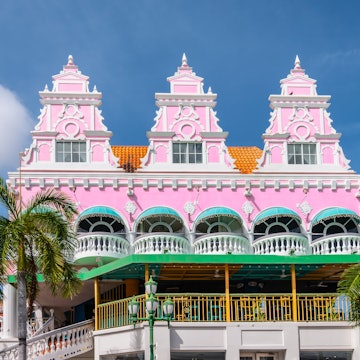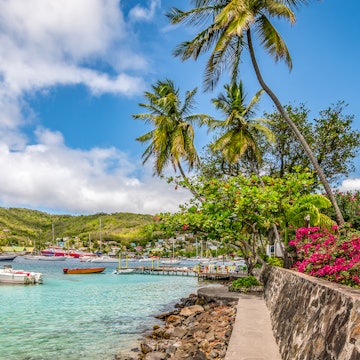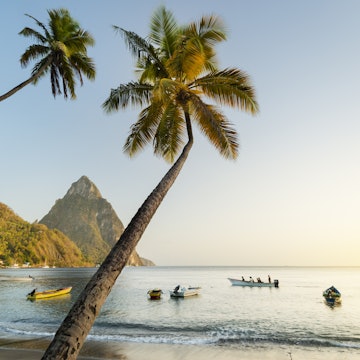

Snorkeling in Belize. Duarte Dellarole/Shutterstock
The Caribbean’s obvious draw is its year-round balmy waters, sunny climes and bespeckled beaches, but the real allure lies below the surface.
Think sublime encounters with marine flora and fauna unabated in color and activity, enough to animate any snorkel story. Aside from knowing how to swim, snorkeling also has little to no barrier to experience, boosted by salty buoyancy.
From coral-taxed shipwrecks to cities of stingrays, the Caribbean offers some of the best snorkeling in the world. Here’s a roundup of the seven best places in the Caribbean to immerse yourself in nature’s aquarium — snorkel and fins in tow.
1. Hol Chan Marine Reserve, Belize
Best for spotting sharks
Hol Chan Marine Reserve earned its distinction as Belize’s most-visited snorkel site, thanks to the docile nurse sharks’ playground of choice.
Found near Ambergris Caye, there are 41,706 hectares of seagrass meadows, mangrove islands and the Belize Barrier Reef — a Unesco site for being the second largest in the world — to explore.
Yet, the Hol Chan channel itself is the highlight for pelagics and chock-a-block patches of reef alone, just deep enough not to risk accidentally kicking coral.
Huge schools of horse-eye jacks, silvery permits, Bermuda chubs and stripy Sergeant majors are a given, while its northern edge homes an elkhorn forest, a small swim-through tunnel and a ledge for larger fish.
Most tours combine a snorkel tour with waist-deep Shark Ray Alley for outright swarms, or the incredibly active Mitchell Rocks, which falls just south of the reserve.
Planning tip: Cold fronts usually stir sediment up, but it has the opposite effect on visibility in Hol Chan, making it the best time to explore underwater.
2. Caracasbaai, Curaçao
Best for shore-accessed variety
The pristine blue Caribbean Sea hugs all three of the ABC islands, but Curaçao’s Tugboat Beach conveniently packages shore access, wreck diving, underwater statues and whimsical coral formations in one place.
The southeastern side of the island offers shelter from trade winds and strong currents. Fins optional, the 30ft intentionally sunk tugboat itself is only 100 yards from shore and 15ft deep, but teems with critters, tawny tube sponges and moray eels.
Swim a minute or two further, and the underwater cliff is the perfect hiding spot for squids, octopus and the occasional sea turtle — unabashed by the hum of a hugely towering resident oil rig. For a free snorkel map of the bay, ask staff at any nearby beach bars.
Planning tip: Parking and admission are free, but snorkel gear rentals carry a tourist tax. Water shoes also aren’t included — the beach itself is coral-rubbled and pebbly.

3. Molinere Beauséjour Marine Protected Area, Grenada
Best for underwater art
Grenada’s underwater sculpture park highlights the fragility of reef systems and climate change.
Hurricane Ivan hit Grenada in 2004 as a Category 3, decimating areas like Molinere Bay. Two years later, the Government collaborated with British sculptor Jason deCaires Taylor for an artificial reef on barren sands.
The result? Approximately 75 beautiful sculptures of pH-neutral cement and steel, strategically placed down-current, now draped in tunicates, gorgonian coral and reef-building stones.
There are favorites, like the iconic outstretched arms of the Christ of the Deep, to the traditional foulard-donning Grenadian woman, proudly flaring her skirt. The Vicissitudes sculpture may be its most photographed; a circle of 26 hand-holding children standing tall, as if on guard.
Planning tip: Only chartered boats access the park, typically from Coconut Beach. Sculptures are visible from the surface; visibility and depth can vary up to 40ft. Free dive or scuba instead to study pockmarked details.
4. Anse Chastanet Beach, St Lucia
Best for shore snorkeling
Powdery soft and entirely free, St Lucia’s beaches are unadulterated bliss for snorkeling. Anse Chastanet is one of the best hideaways to do it.
Calmest here on the island’s leeward side, swim minutes from shoreline to fringing reef to spot giant sponges, hundreds of angelfish, massive coral-lined boulders and even the occasional sea turtle.
Anse Chastanet stretches some 400m, making it perfect for a drift snorkel within clearly marked buoys and differentiating zones for different highlights. For more of a thrill, jump on a nighttime snorkel, available every other night.
Planning tip: Hawksbill turtles lay on this beach, with hatchlings spotted between September and October.
5. Starfish Point, Grand Cayman
Best for seeing starfish
You’re here for one thing only – the red cushion starfish. Other fish are transient to these sandy shores and seagrass beds, but those sun-dappled and brick-hued studded invertebrates make this sight a shoe-in on this list.
Sizes and numbers of starfish may vary, as nature does, depending on ocean currents and temperature, but there’ll always be more than a handful to enchant.
Non-snorkelers can revel at Starfish Point’s access too. The free parking lot is directly on the shorefront, and ankle-deep water in some spots means no gear (or skill) required to indulge.
Although there are public restrooms and some shaded areas here, there aren’t any vendors, even for sunscreen. Plan ahead, or drop into Kaibo or Rum Point for food and drinks.
Planning tip: Starfish Point is safely secluded, and you’ll have it to yourself mornings, before Stingray City tour groups arrive. For options closer to town, consider Wreck of the Cali and Smith Cove.

6. Montego Bay Marine Park, Jamaica
Best for families and beginners
A country known for its beautiful beaches, Montego Bay’s Marine Park is a wonderful spot for snorkeling.
Airport Reef attracts fans with its stingray-thronged caverns, while Beer Star is known for its less-frequented reefs further from shore. But the five-mile Doctor’s Cave Beach is an excellent introduction to shore snorkeling — a squat wade or pier jump away.
With protected status and a cement pier to draw in sheltering juvenile marine life like crabs, stingrays, parrotfish, pufferfish and angelfish are your most common sights, while the venomous and visually explosive lionfish is a sight best indulged in from a distance. For fewer crowds, choose a non-cruise ship day.
Planning tip: Like most Jamaican beaches, onsite ticket booths charge US$6-10 entry, but include parking and amenities. Seasonally, Glistening Waters at Falmouth have bioluminescence, with nighttime snorkels.
7. Andros Island, Bahamas
Best for blue holes
With the highest concentration of underwater caves and sinkholes worldwide, Andros Island in The Bahamas is also the third-largest fringing barrier reef, a handful of miles shy of Belize’s.
And like its CARICOM-mate Belize, The Bahamas also boasts its own Blue Hole with Dean’s, ringed by grassy cliffs and a sandy beach with surprisingly excellent snorkeling.
Reef fish school around the brim of its inky 663ft center, while sting rays, turtles and crabs frequent its shallower seagrasses. It’s easy to lose track of time in the intrigue of colors — from mottled red crawfish to starkly different salty blues — while snorkeling.
Planning tip: Although free and easily accessible, you’ll need to self-drive. Go early for the quietest, serenest time.














